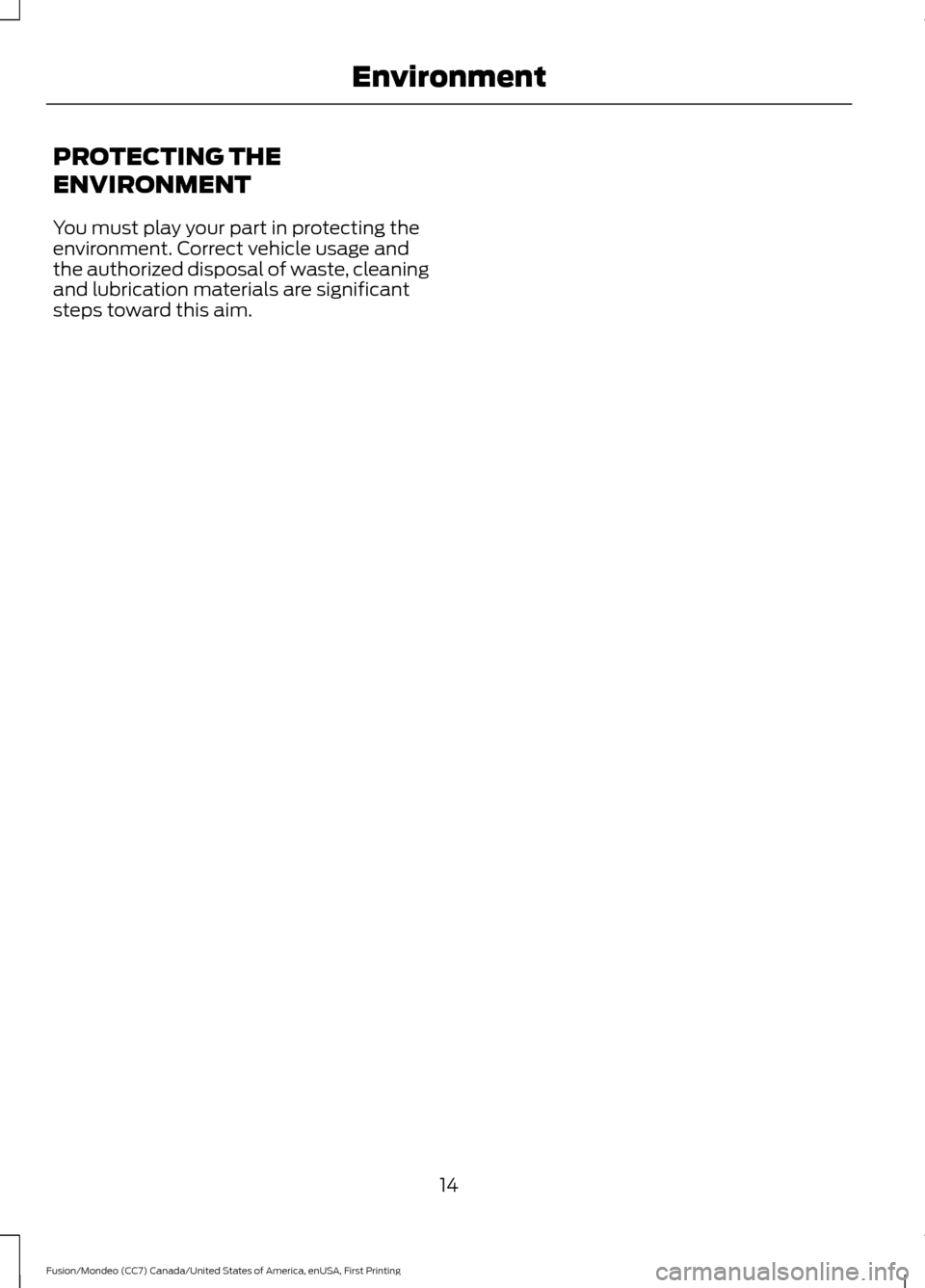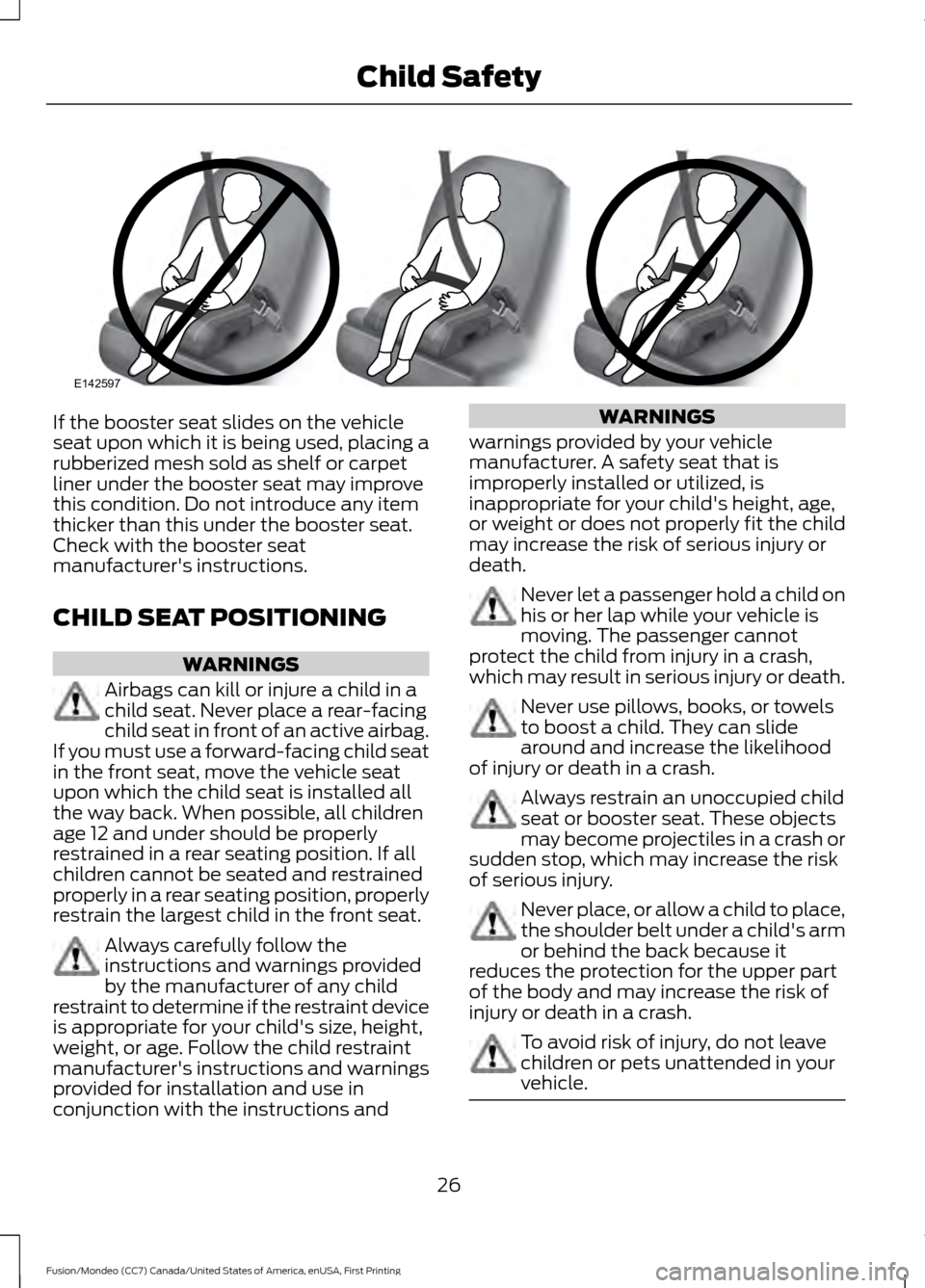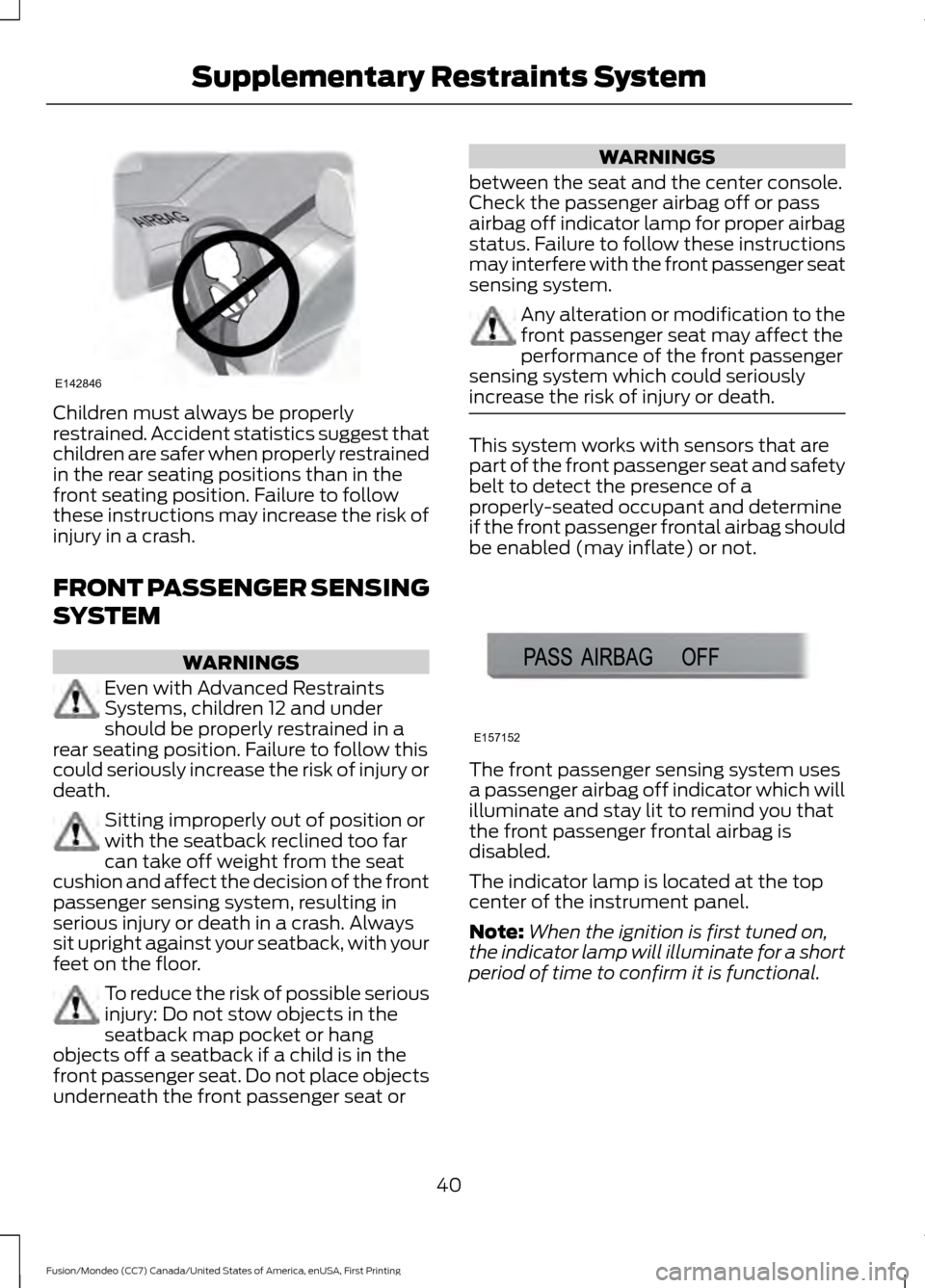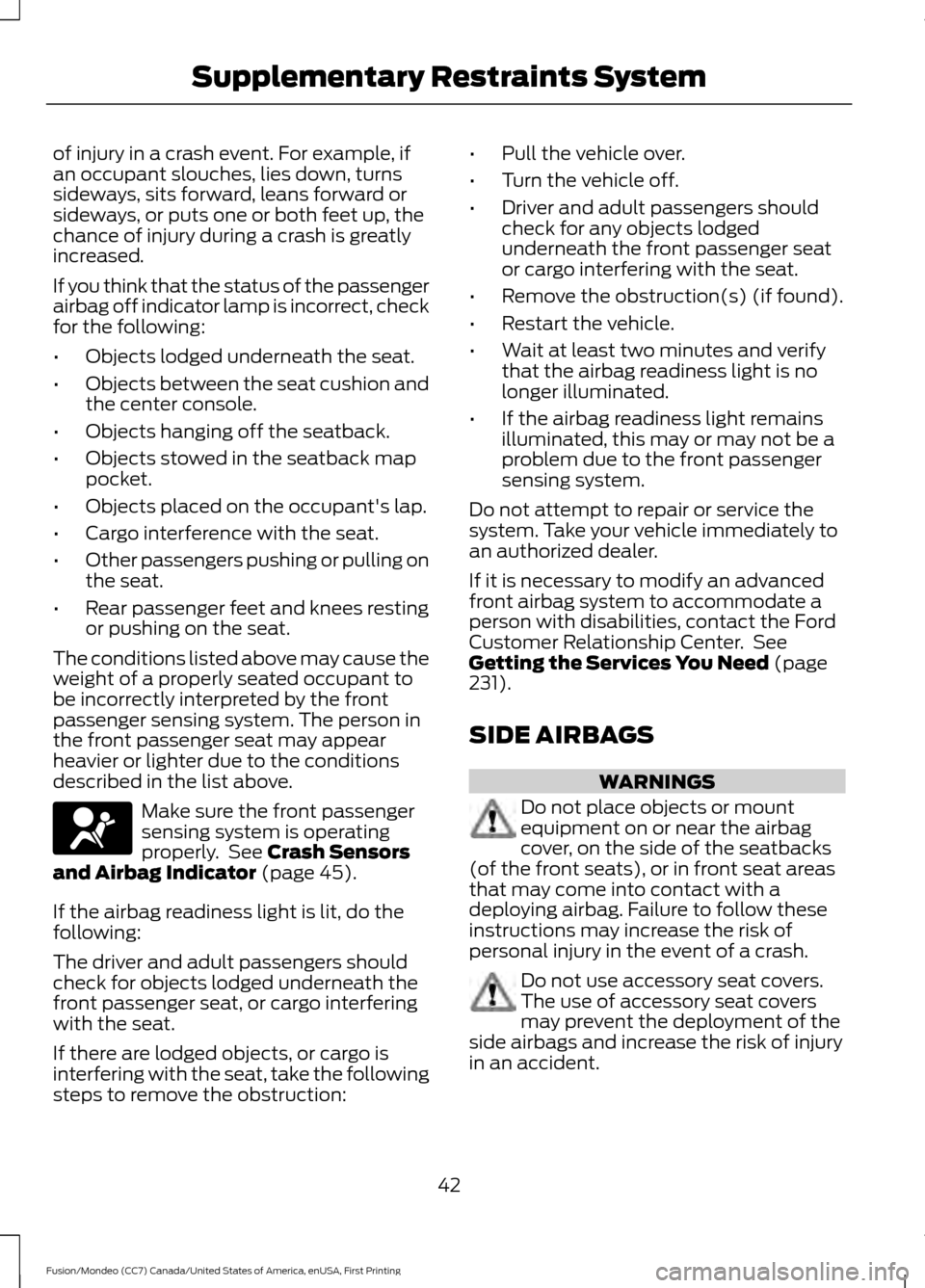2016 FORD FUSION (AMERICAS) tow
[x] Cancel search: towPage 5 of 518

Heated Steering Wheel................................73
Wipers and Washers
Windshield Wipers
.........................................74
Autowipers........................................................74
Windshield Washers......................................75
Lighting
General Information
.......................................77
Lighting Control
...............................................77
Autolamps........................................................78
Instrument Lighting Dimmer
......................79
Headlamp Exit Delay....................................79
Daytime Running Lamps............................80
Automatic High Beam Control.................80
Front Fog Lamps
............................................82
Direction Indicators
.......................................82
Interior Lamps.................................................82
Ambient Lighting
............................................83
Windows and Mirrors
Power Windows.............................................84
Global Opening and Closing......................85
Exterior Mirrors
................................................85
Interior Mirror
...................................................86
Sun Visors
.........................................................87
Moonroof...........................................................87
Instrument Cluster
Gauges...............................................................89
Warning Lamps and Indicators..................91
Audible Warnings and Indicators.............95
Information Displays
General Information.....................................96
Information Messages
................................105
Climate Control
Manual Climate Control............................120 Automatic Climate Control -
Vehicles
Without: Sony Audio System...............122
Automatic Climate Control -
Vehicles
With: Sony Audio System/Sony Audio
System
..........................................................123
Hints on Controlling the Interior Climate.........................................................125
Heated Windows and Mirrors
..................128
Cabin Air Filter
................................................128
Remote Start
..................................................129
Seats
Sitting in the Correct Position..................130
Head Restraints............................................130
Manual Seats.................................................132
Power Seats
....................................................132
Memory Function.........................................134
Rear Seats.......................................................136
Heated Seats
..................................................137
Climate Controlled Seats...........................137
Rear Seat Armrest........................................138
Universal Garage Door Opener
Universal Garage Door Opener...............139
Auxiliary Power Points
Auxiliary Power Points................................143
Storage Compartments
Center Console
..............................................145
Overhead Console
........................................145
Starting and Stopping the Engine
General Information
....................................146
Ignition Switch
...............................................146
Keyless Starting............................................146
Starting a Gasoline Engine........................147
Engine Block Heater....................................150
2
Fusion/Mondeo (CC7) Canada/United States of America, enUSA, First Printing Table of Contents
Page 6 of 518

Unique Driving Character-
istics
Auto-Start-Stop............................................152
Fuel and Refueling
Safety Precautions......................................154
Fuel Quality.....................................................155
Fuel Filler Funnel Location
........................155
Running Out of Fuel....................................156
Refueling..........................................................157
Fuel Consumption.......................................159
Emission Control System..........................160
Transmission
Automatic Transmission............................163
All-Wheel Drive
Using All-Wheel Drive.................................167
Brakes
General Information.....................................172
Hints on Driving With Anti-Lock Brakes............................................................172
Electric Parking Brake
..................................173
Hill Start Assist
..............................................175
Traction Control
Principle of Operation..................................177
Using Traction Control
.................................177
Stability Control
Principle of Operation.................................178
Using Stability Control
................................178
Parking Aids
Principle of Operation.................................179
Rear Parking Aid............................................179
Front Parking Aid
..........................................180
Active Park Assist..........................................181 Rear View Camera.......................................184
Cruise Control
Principle of Operation................................188
Using Cruise Control...................................188
Using Adaptive Cruise Control................189
Driving Aids
Driver Alert
......................................................196
Lane Keeping System.................................197
Blind Spot Information System
..............201
Steering...........................................................205
Pre-Collision Assist
....................................206
Load Carrying
Load Limit
......................................................209
Towing
Towing a Trailer..............................................217
Recommended Towing Weights............218
Essential Towing Checks...........................219
Towing Points
...............................................220
Transporting the Vehicle............................221
Towing the Vehicle on Four Wheels......222
Driving Hints
Breaking-In.....................................................223
Economical Driving
.....................................223
Driving Through Water
...............................223
Floor Mats.......................................................224
Roadside Emergencies
Roadside Assistance
..................................226
Hazard Warning Flashers..........................227
Fuel Shutoff
....................................................227
Jump Starting the Vehicle........................228
Post-Crash Alert System
..........................230
Spinout Detection
.......................................230
3
Fusion/Mondeo (CC7) Canada/United States of America, enUSA, First Printing Table of Contents
Page 17 of 518

PROTECTING THE
ENVIRONMENT
You must play your part in protecting the
environment. Correct vehicle usage and
the authorized disposal of waste, cleaning
and lubrication materials are significant
steps toward this aim.
14
Fusion/Mondeo (CC7) Canada/United States of America, enUSA, First Printing Environment
Page 22 of 518

8.
Remove remaining slack from the belt.
Force the seat down with extra weight,
for example, by pressing down or
kneeling on the child restraint while
pulling up on the shoulder belt in order
to force slack from the belt. This is
necessary to remove the remaining
slack that will exist once the extra
weight of the child is added to the child
restraint. It also helps to achieve the
proper snugness of the child seat to
your vehicle. Sometimes, a slight lean
toward the buckle will provide extra
help to remove remaining slack from
the belt.
9. Attach the tether strap (if the child seat
is equipped). 10. Before placing the child in the seat,
forcibly move the seat forward and
back to make sure the seat is securely
held in place. To check this, grab the
seat at the belt path and attempt to
move it side to side and forward and
back. There should be no more than
1 inch (2.5 centimeters) of movement
for proper installation.
Ford recommends checking with a NHTSA
Certified Child Passenger Safety
Technician to make certain the child
restraint is properly installed. In Canada,
check with your local St. John Ambulance
office for referral to a Certified Passenger
Seat Technician. Inflatable safety belts
1. Position the child safety seat in a seat
with a combination lap and shoulder
belt. 2. After positioning the child safety seat
in the proper seating position, grasp the
shoulder belt and lap belt together
behind the belt tongue. 19
Fusion/Mondeo (CC7) Canada/United States of America, enUSA, First Printing Child SafetyE142534 E142528 E146522 E142530
Page 24 of 518

slack that will exist once the extra
weight of the child is added to the child
restraint. It also helps to achieve the
proper snugness of the child seat to
your vehicle. Sometimes, a slight lean
toward the buckle will additionally help
to remove remaining slack from the
belt.
9. Attach the tether strap (if the child seat
is equipped). 10. Before placing the child in the seat,
forcibly move the seat forward and
back to make sure the seat is securely
held in place. To check this, grab the
seat at the belt path and attempt to
move it side to side and forward and
back. There should be no more than
1 inch (2.5 centimeters) of movement
for proper installation.
Ford recommends checking with a NHTSA
Certified Child Passenger Safety
Technician to make certain the child
restraint is properly installed. In Canada,
check with your local St. John Ambulance
office for referral to a Certified Passenger
Seat Technician. Using Lower Anchors and Tethers
for CHildren (LATCH) WARNINGS
Never attach two child safety seats
to the same anchor. In a collision, one
anchor may not be strong enough to
hold two child safety seat attachments
and may break, causing serious injury or
death. Depending on where you secure a
child restraint, and depending on the
child restraint design, you may block
access to certain safety belt buckle
assemblies or LATCH lower anchors,
rendering those features potentially
unusable. To avoid risk of injury, occupants
should only use seating positions where
they are able to be properly restrained. The LATCH system is composed of three
vehicle anchor points: two lower anchors
located where seat back and seat cushion
meet (called the seat bight) and one top
tether anchor located behind that seating
position.
LATCH compatible child safety seats have
two rigid or webbing mounted
attachments that connect to the two lower
anchors at the LATCH equipped seating
positions in your vehicle. This type of
attachment method eliminates the need
to use safety belts to attach the child seat,
however the safety belt can still be used
to attach the child seat. For forward-facing
child seats, the top tether strap must also
be attached to the proper top tether
anchor, if a top tether strap has been
provided with your child seat.
21
Fusion/Mondeo (CC7) Canada/United States of America, enUSA, First Printing Child SafetyE142534
Page 29 of 518

If the booster seat slides on the vehicle
seat upon which it is being used, placing a
rubberized mesh sold as shelf or carpet
liner under the booster seat may improve
this condition. Do not introduce any item
thicker than this under the booster seat.
Check with the booster seat
manufacturer's instructions.
CHILD SEAT POSITIONING
WARNINGS
Airbags can kill or injure a child in a
child seat. Never place a rear-facing
child seat in front of an active airbag.
If you must use a forward-facing child seat
in the front seat, move the vehicle seat
upon which the child seat is installed all
the way back. When possible, all children
age 12 and under should be properly
restrained in a rear seating position. If all
children cannot be seated and restrained
properly in a rear seating position, properly
restrain the largest child in the front seat. Always carefully follow the
instructions and warnings provided
by the manufacturer of any child
restraint to determine if the restraint device
is appropriate for your child's size, height,
weight, or age. Follow the child restraint
manufacturer's instructions and warnings
provided for installation and use in
conjunction with the instructions and WARNINGS
warnings provided by your vehicle
manufacturer. A safety seat that is
improperly installed or utilized, is
inappropriate for your child's height, age,
or weight or does not properly fit the child
may increase the risk of serious injury or
death. Never let a passenger hold a child on
his or her lap while your vehicle is
moving. The passenger cannot
protect the child from injury in a crash,
which may result in serious injury or death. Never use pillows, books, or towels
to boost a child. They can slide
around and increase the likelihood
of injury or death in a crash. Always restrain an unoccupied child
seat or booster seat. These objects
may become projectiles in a crash or
sudden stop, which may increase the risk
of serious injury. Never place, or allow a child to place,
the shoulder belt under a child's arm
or behind the back because it
reduces the protection for the upper part
of the body and may increase the risk of
injury or death in a crash. To avoid risk of injury, do not leave
children or pets unattended in your
vehicle.
26
Fusion/Mondeo (CC7) Canada/United States of America, enUSA, First Printing Child SafetyE142597
Page 43 of 518

Children must always be properly
restrained. Accident statistics suggest that
children are safer when properly restrained
in the rear seating positions than in the
front seating position. Failure to follow
these instructions may increase the risk of
injury in a crash.
FRONT PASSENGER SENSING
SYSTEM
WARNINGS
Even with Advanced Restraints
Systems, children 12 and under
should be properly restrained in a
rear seating position. Failure to follow this
could seriously increase the risk of injury or
death. Sitting improperly out of position or
with the seatback reclined too far
can take off weight from the seat
cushion and affect the decision of the front
passenger sensing system, resulting in
serious injury or death in a crash. Always
sit upright against your seatback, with your
feet on the floor. To reduce the risk of possible serious
injury: Do not stow objects in the
seatback map pocket or hang
objects off a seatback if a child is in the
front passenger seat. Do not place objects
underneath the front passenger seat or WARNINGS
between the seat and the center console.
Check the passenger airbag off or pass
airbag off indicator lamp for proper airbag
status. Failure to follow these instructions
may interfere with the front passenger seat
sensing system. Any alteration or modification to the
front passenger seat may affect the
performance of the front passenger
sensing system which could seriously
increase the risk of injury or death. This system works with sensors that are
part of the front passenger seat and safety
belt to detect the presence of a
properly-seated occupant and determine
if the front passenger frontal airbag should
be enabled (may inflate) or not.
The front passenger sensing system uses
a passenger airbag off indicator which will
illuminate and stay lit to remind you that
the front passenger frontal airbag is
disabled.
The indicator lamp is located at the top
center of the instrument panel.
Note:
When the ignition is first tuned on,
the indicator lamp will illuminate for a short
period of time to confirm it is functional.
40
Fusion/Mondeo (CC7) Canada/United States of America, enUSA, First Printing Supplementary Restraints SystemE142846 E157152
Page 45 of 518

of injury in a crash event. For example, if
an occupant slouches, lies down, turns
sideways, sits forward, leans forward or
sideways, or puts one or both feet up, the
chance of injury during a crash is greatly
increased.
If you think that the status of the passenger
airbag off indicator lamp is incorrect, check
for the following:
•
Objects lodged underneath the seat.
• Objects between the seat cushion and
the center console.
• Objects hanging off the seatback.
• Objects stowed in the seatback map
pocket.
• Objects placed on the occupant's lap.
• Cargo interference with the seat.
• Other passengers pushing or pulling on
the seat.
• Rear passenger feet and knees resting
or pushing on the seat.
The conditions listed above may cause the
weight of a properly seated occupant to
be incorrectly interpreted by the front
passenger sensing system. The person in
the front passenger seat may appear
heavier or lighter due to the conditions
described in the list above. Make sure the front passenger
sensing system is operating
properly. See Crash Sensors
and Airbag Indicator (page 45).
If the airbag readiness light is lit, do the
following:
The driver and adult passengers should
check for objects lodged underneath the
front passenger seat, or cargo interfering
with the seat.
If there are lodged objects, or cargo is
interfering with the seat, take the following
steps to remove the obstruction: •
Pull the vehicle over.
• Turn the vehicle off.
• Driver and adult passengers should
check for any objects lodged
underneath the front passenger seat
or cargo interfering with the seat.
• Remove the obstruction(s) (if found).
• Restart the vehicle.
• Wait at least two minutes and verify
that the airbag readiness light is no
longer illuminated.
• If the airbag readiness light remains
illuminated, this may or may not be a
problem due to the front passenger
sensing system.
Do not attempt to repair or service the
system. Take your vehicle immediately to
an authorized dealer.
If it is necessary to modify an advanced
front airbag system to accommodate a
person with disabilities, contact the Ford
Customer Relationship Center. See
Getting the Services You Need
(page
231).
SIDE AIRBAGS WARNINGS
Do not place objects or mount
equipment on or near the airbag
cover, on the side of the seatbacks
(of the front seats), or in front seat areas
that may come into contact with a
deploying airbag. Failure to follow these
instructions may increase the risk of
personal injury in the event of a crash. Do not use accessory seat covers.
The use of accessory seat covers
may prevent the deployment of the
side airbags and increase the risk of injury
in an accident.
42
Fusion/Mondeo (CC7) Canada/United States of America, enUSA, First Printing Supplementary Restraints System